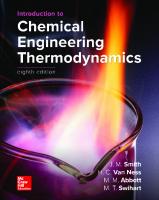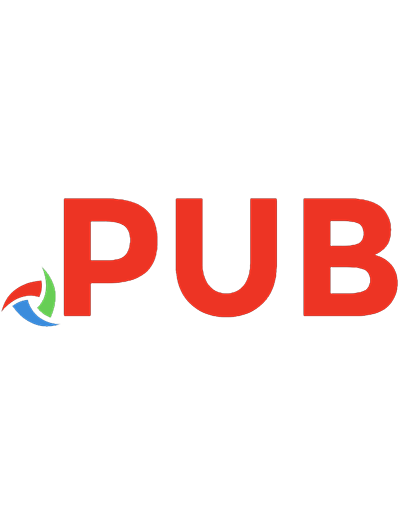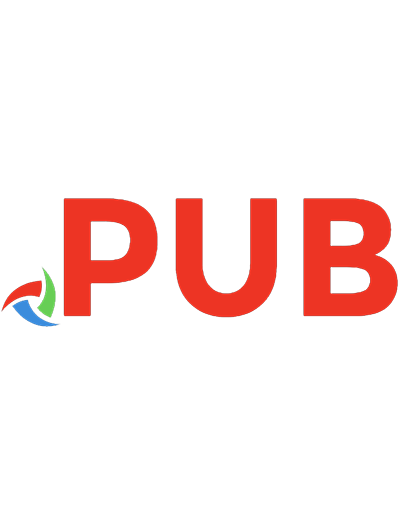Chemical and Engineering Thermodynamics [3 ed.] 0471182109
This book is intended to be the text for a course in thermodynamics for undergraduate students in chemical engineering.
137 87 10MB
English Pages XX; 772 [796] Year 1999
Polecaj historie
Table of contents :
Title Page
Preface
Dedication
About the Author
Table of Contents
Notation
Special Notation
General Notation
Subscripts
Superscripts
Chapter 1 - INTRODUCTION
1.1 The Central Problems of Thermodynamics
1.2 A System of Units
1.3 The Equilibrium State
1.4 Pressure, Temperature, and Equilibrium
1.5 Heat, Work, and the Conservation of Energy
1.6 Specification of the Equilibrium State; Intensive and Extensive Variables; Equations of State
1.7 A Summary of Important Experimental Observations
1.8 A Comment on the Development of Thermodynamics
Problems
Chapter 2 - CONSERVATION OF MASS AND ENERGY
2.1 A General Balance Equation and Conserved Quantities
2.2 Conservation of Mass
2.3 Conservation of Energy
2.4 The Thermodynamic Properties of Matter
2.5 Applications of the Mass and Energy Balances
2.6 Conservation of Momentum
2.7 The Microscopic Equations of Change for Thermodynamics and Fluid Mechanics (Optional)
Problems
Chapter 3 - ENTROPY: AN ADDITIONAL BALANCE EQUATION
3.1 Entropy: A New Concept
3.2 The Entropy Balance and Reversibility
3.3 Heat, Work, Engines, and Entropy
3.4 Entropy Changes of Matter
3.5 Applications of the Entropy Balance
3.6 Liquefaction
3.7 Power Generation and Refrigeration Cycles
3.8 The Thermodynamics of Mechanical Explosions
3.9 The Microscopic Entropy Balance (Optional)
Problems
Chapter 4 - THE THERMODYNAMIC PROPERTIES OF REAL SUBSTANCES
4.1 Some Mathematical Preliminaries
4.2 The Evaluation of Thermodynamic Partial Derivatives
4.3 The Ideal Gas and Absolute-Temperature Scales
4.4 The Evaluation of Changes in the Thermodynamic Properties of Real Substances Accompanying a Change of State
4.5 An Example Involving the Change of State of a Real Gas
4.6 The Principle of Corresponding States
4.7 Generalized Equations of State
4.8 The Third Law of Thermodynamics
4.9 More About Thermodynamic Partial Derivatives (Optional)
Appendix A4.1 A Program for Thermodynamic PropertiesCalculations Using the Peng-Robinson Cubic Equationof State, PR1
Problems
Chapter 5 - EQUILIBRIUM AND STABILITY IN ONE-COMPONENT SYSTEMS
5.1 The Criteria for Equilibrium
5.2 Stability of Thermodynamic Systems
5.3 Phase Equilibria: Application of the Equilibrium and StabilityCriteria to the Equation of State
5.4 The Molar Gibbs Free Energy and Fugacity of a PureComponent
5.5 The Calculation of Pure Fluid-Phase Equilibrium: The Computationof Vapor Pressure from an Equation of State
5.6 The Specification of the Equilibrium Thermodynamic State of aSystem of Several Phases: The Gibbs Phase Rule for a One-Component System
5.7 Thermodynamic Properties of Phase Transitions
Problems
Chapter 6 - THE THERMODYNAMICS OF MULTICOMPONENT MIXTURES
6.1 The Thermodynamic Description of Mixtures
6.2 The Partial Molar Gibbs Free Energy and the Generalized Gibbs-Duhem Equation
6.3 A Notation for Chemical Reactions
6.4 The Equations of Change for a Multicomponent System
6.5 The Heat of Reaction and a Convention for the Thermodynamic Properties of Reacting Mixtures
6.6 The Experimental Determination of the Partial Molar Volume and Enthalpy
6.7 Criteria for Phase Equilibrium in Multicomponent Systems
6.8 The Criteria for Chemical Equilibrium, and Combined Chemical andPhase Equilibrium
6.9 The Specification of the Equilibrium Thermodynamic State of a Multicomponent, Multiphase System; the Gibbs Phase Rule
6.10 Some Concluding Remarks
Problems
Chapter 7 - THE ESTIMATION OF THE GIBBS FREE ENERGY AND FUGACITY OF A COMPONENT IN A MIXTURE
7.1 The Ideal Gas Mixture
7.2 The Partial Molar Gibbs Free Energy and Fugacity
7.3 The Ideal Mixture and Excess Mixture Properties
7.4 The Fugacity of Species in Gaseous, Liquid, and Solid Mixtures
7.5 Several Correlative Liquid Mixture (Activity Coefficient) Models
7.6 Two Predictive Activity Coefficient Models
7.7 A Corresponding States Principle for Mixtures; The Pseudocritical Constant Method
7.8 The Fugacity of Species in Nonsimple Mixtures
7.9 Some Comments on Reference and Standard States
7.10 A Combined Equation-of-State-Excess Gibbs Free EnergyModels
7.11 Electrolyte Solutions
7.12 Concluding Remarks
Appendix A7.1 A Statistical Mechanical Interpretation of the Entropy ofMixing in an Ideal Mixture
Appendix A7.2 A Program for Multicomponent Vapor-Liquid Equilibrium Calculations Using the Peng-Robinson Cubic Equation of State, VLMU
Appendix A7.3 Multicomponent Excess Gibbs Free Energy (Activity Coefficient) Models
Appendix A7.4 A Program for the Prediction of Activity Coefficients and Low Pressure Vapor-Liquid Equilibrium Using theUNIFAC Model, UNIFAC
Problems
Chapter 8 - PHASE EQUILIBRIUM IN MIXTURES
8.1 Vapor-Liquid Equilibria Using Activity Coefficient Models
Problems for Section 8.1
8.2 Vapor-Liquid Equilibria Using Equations of State
Problems for Section 8.2
8.3 The Solubility of a Gas in a Liquid
Problems for Section 8.3
8.4 The Solubility of a Liquid in a Liquid and Vapor-Liquid-Liquid Equilibrium
Problems for Section 8.4
8.5 The Solubility of a Solid in a Liquid, Gas, or Supercritical Fluid
Problems for Section 8.5
8.6 The Partitioning of a Solute Among Two Coexisting Liquid Phases; The Distribution Coefficient
Problems for Section 8.6
8.7 Freezing-Point Depression of a Solvent Due to the Presence of a Solute; the Freezing Point of Liquid Mixtures
Problems for Section 8.7
8.8 Osmotic Equilibrium and Osmotic Pressure
Problems for Section 8.8
8.9 The Phase Behavior Modeling of Chemicals in the Environment
Problems for Section 8.9
8.10 The Phase Behavior of Solid Mixtures
Problems for Section 8.10
8.11 Concluding Remarks
Additional Phase Equilibrium Problems
Chapter 9 - CHEMICAL EQUILIBRIUM AND THE BALANCE EQUATIONS FOR CHEMICALLY REACTING SYSTEMS
9.1 Chemical Equilibrium in a Single-Phase System
9.2 Heterogeneous Chemical Reactions
9.3 Chemical Equilibrium When Several Reactions Occur in a Single Phase
9.4 Combined Chemical and Phase Equilibrium
9.5 The Balance Equations for a Tank-Type Chemical Reactor
9.6 The Balance Equations for a Thbular Reactor
9.7 Overall Reactor Balance Equations and the Adiabatic Reaction Temperature
9.8 The Thermodynamics of Chemical Explosions
9.9 Introduction to Electrochemical Processes
9.10 Coupled Chemical Reactions
Appendix A9.1 A Program for the Calculation of Chemical EquilibriumConstants As a Function of Temperature, CHEMEQ
Problems
Appendices
Appendix I Conversion Factors for SI Units
Appendix II The Molar Heat Capacities of Gases in the Ideal Gas (Zero Pressure) State
Appendix III The Thermodynamic Properties of Water and Steam
Appendix IV Enthalpies and Free Energies of Formation
Appendix V Heats of Combustion
Index
Citation preview
Abbreviated list of SI units Physical Quantity Basic units Length Mass Time Electric current Temperature Amount of substance Luminous intensity
SI Unit
Symbol
meter kilogram second ampere kelvin mole candela
m kg s A K mol cd
Derived units with assigned names Energy joule Force newton Power watt Electric charge coloumb Electric potential difference volt Pressure pascal Frequency hertz
J N W C V Pa Hz
Derived units without assigned names Area square meter Volume cubic meter Density cubic meter kilogram per Molar heat capacity joule per mole Kelvin Specific heat capacity joule per kilogram Kelvin Concentration mole per cubic meter
m2 m3 kg m−1 J mol−1 K−1 J kg−1 K−1 mol m−3
Units and conversion factors Length: Mass: Energy:
Pressure:
Molar Heat Capacity: Specific Heat Capacity:
Power:
Relation to Other SI Units
J = kg m2 s−2 N = kg m s−2 = J m−1 W = kg m2 s−3 = J s−1 C = As V = kg m2 s−3 A−1 = J A−1 s−1 Pa = kg m−1 s−2 = N m−2 s−1
The Gas Constant 1 m = 3.281 feet 1 kg = 2.2046 pounds 1 J = 1 watt-second = 107 ergs = 107 dyne-cm = 0.2390 cal = 0.948 × 10−3 BTU = 0.7376 ft-lb = 0.9868 × 10−2 liter-atm 1 Pa = 1 newton m−2 = 1 joule m−3 = 0.9869 × 10−5 atmospheres = 0.750 × 10−2 millimeters of energy = 1 × 10−5 bars = 1.450 × 10−4 psi
1 J mol−1 K−1 = 0.2390 cal(mol K)−1 = 0.2390 BTU(lb-mol ◦ F)−1 1 J g−1 K−1 = 0.2390 cal(g K)−1 = 0.2390 BTU(lb ◦ F)−1 = 1 kJ (kg K)−1 1 J sec−1 = 1 watt = 0.1341 × 10−2 horsepower (hp) = 0.7356 ft-lbf /sec = 0.948 × 10−3 BTU/sec
R = 8.314 = 8.314 = 8.314 × 10−3 = 8.314 × 10−5 = 8.314 × 10−2 = 8.314 × 10−6
J/mol K N m/mol K kPa m3 /mol K bar m3 /mol K bar m3 /kmol K MPa m3 /mol K
Contents NOTATION
xv
CHAPTERl
INTRODUCTION 1.1 The Central Problems of Thermodynamics 1 1.2 A System of Units 3 1.3 The Equilibrium State 5 1.4 Pressure, Temperature, and Equilibrium 7 1.5 Heat, Work, and the Conservation of Energy 12 1.6 Specification of the Equilibrium State; Intensive and Extensive Variables; Equations of State 15 1.7 A Summary of Important Experimental Observations 18 1.8 A Comment on the Development of Thermodynamics 20 Problems 20
1
CHAPTER 2
CONSERVATION OF MASS AND ENERGY 2.1 A General Balance Equation and Conserved Quantities 23 2.2 Conservation of Mass 27 2.3 Conservation of Energy 30 2.4 The Thermodynamic Properties of Matter 43 2.5 Applications of the Mass and Energy Balances 51 2.6 Conservation of Momentum 75 2.7 The Microscopic Equations of Change for Thermodynamics and Fluid Mechanics (Optional) 76 Problems 82
22
CHAPTER 3
ENTROPY: AN ADDITIONAL BALANCE EQUATION 3.1 Entropy: A New Concept 90 3.2 The Entropy Balance and Reversibility 97 3.3 Heat, Work, Engines, and Entropy 103 3.4 Entropy Changes of Matter 112 3.5 Applications of the Entropy Balance 115 3.6 Liquefaction 128
89
xi
xii
Contents 3.7 Power Generation and Refrigeration Cycles 132 3.8 The Thermodynamics of Mechanical Explosions 154 3.9 The Microscopic Entropy Balance (Optional) 163 Problems 165
CHAPTER 4
THE THERMODYNAMIC PROPERTIES OF REAL SUBSTANCES
17S
4.1 4.2 4.3 4.4
Some Mathematical Preliminaries 175 The Evaluation of Thermodynamic Partial Derivatives 179 The Ideal Gas and Absolute-Temperature Scales 194 The Evaluation of Changes in the Thermodynamic Properties of Real Substances Accompanying a Change of State 195 4.5 An Example Involving the Change of State of a Real Gas 219 4.6 The Principle of Corresponding States 225 4.7 Generalized Equations of State 238 4.8 The Third Law of Thermodynamics 242 4.9 More About Thermodynamic Partial Derivatives (Optional) 243 Appendix A4.1 A Program for Thermodynamic Properties Calculations Using the Peng-Robinson Cubic Equation of State, PR1 249 Problems 251
CHAPTERS
EQUILIBRIUM AND STABILITY IN ONE-COMPONENT SYSTEMS
260
5.1 The Criteria for Equilibrium 260 5.2 Stability of Thermodynamic Systems 265 5.3 Phase Equilibria: Application of the Equilibrium and Stability Criteria to the Equation of State 272 5.4 The Molar Gibbs Free Energy and Fugacity of a Pure Component 279 5.5 The Calculation of Pure Fluid-Phase Equilibrium: The Computation of Vapor Pressure from an Equation of State 295 5.6 The Specification of the Equilibrium Thermodynamic State of a System of Several Phases: The Gibbs Phase Rule for a One-Component System 303 5.7 Thermodynamic Properties of Phase Transitions 307 Problems 313
CHAPTER 6
THE THERMODYNAMICS OF MULTICOMPONENT MIXTURES 6.1 The Thermodynamic Description of Mixtures 324 6.2 The Partial Molar Gibbs Free Energy and the Generalized Gibbs-Duhem Equation 333 6.3 A Notation for Chemical Reactions 337 6.4 The Equations of Change for a Multicomponent System 340
324
Contents xiii 6.5 The Heat of Reaction and a Convention for the Thermodynamic Properties of Reacting Mixtures 349 6.6 The Experimental Determination of the Partial Molar Volume and Enthalpy 354 6.7 Criteria for Phase Equilibrium in Multicomponent Systems 364 6.8 The Criteria for Chemical Equilibrium, and Combined Chemical and Phase Equilibrium 368 6.9 The Specification of the Equilibrium Thermodynamic State of a Multicomponent, Multiphase System; the Gibbs Phase Rule 373 6.10 Some Concluding Remarks 377 Problems 377
CHAPTER 7
THE ESTIMATION OF THE GIBBS FREE ENERGY AND FUGACITY OF A COMPONENT IN A MIXTURE
388
7.1 7.2 7.3 7.4 7.5
The Ideal Gas Mixture 388 The Partial Molar Gibbs Free Energy and Fugacity 392 The Ideal Mixture and Excess Mixture Properties 396 The Fugacity of Species in Gaseous, Liquid, and Solid Mixtures 406 Several Correlative Liquid Mixture (Activity Coefficient) Models 414 7.6 Two Predictive Activity Coefficient Models 428 7.7 A Corresponding States Principle for Mixtures; The Pseudocritical Constant Method 437 7.8 The Fugacity of Species in Nonsimple Mixtures 444 7.9 Some Comments on Reference and Standard States 451 7.10 A Combined Equation-of-State-Excess Gibbs Free Energy Models 452 7.11 Electrolyte Solutions 455 7.12 Concluding Remarks 461 Appendix A7.1 A Statistical Mechanical Interpretation of the Entropy of Mixing in an Ideal Mixture 464 Appendix A7.2 A Program for Multicomponent Vapor-Liquid Equilibrium Calculations Using the Peng-Robinson Cubic Equation of State, VLMU 467 Appendix A7.3 Multicomponent Excess Gibbs Free Energy (Activity Coefficient) Models 468 Appendix A7.4 A Program for the Prediction of Activity Coefficients and Low Pressure Vapor-Liquid Equilibrium Using the UNIFAC Model, UNIFAC. 470 Problems 471
CHAPTERS
PHASE EQUILIBRIUM IN MIXTURES 8.1 Vapor-Liquid Equilibria Using Activity Coefficient Models Problems for Section 8.1 511 8.2 Vapor-Liquid Equilibria Using Equations of State 518 Problems for Section 8.2 534 8.3 The Solubility of a Gas in a Liquid 536
478 478
xiv Contents Problems for Section 8.3 547 8.4 The Solubility of a Liquid in a Liquid and Vapor-Liquid-Liquid Equilibrium 550 Problems for Section 8.4 571 8.5 The Solubility of a Solid in a Liquid, Gas, or Supercritical Fluid 575 Problems for Section 8.5 585 8.6 The Partitioning of a Solute Among Two Coexisting Liquid Phases; The Distribution Coefficient 586 Problems for Section 8.6 597 8.7 Freezing-Point Depression of a Solvent Due to the Presence of a Solute; the Freezing Point of Liquid Mixtures 598 Problems for Section 8.7 602 8.8 Osmotic Equilibrium and Osmotic Pressure 603 Problems for Section 8.8 606 8.9 The Phase Behavior Modeling of Chemicals in the Environment 608 Problems for Section 8.9 613 8.10 The Phase Behavior of Solid Mixtures 614 Problems for Section 8.10 622 8.11 Concluding Remarks 623 Additional Phase Equilibrium Problems 624
CHAPTER 9
CHEMICAL EQUILIBRIUM AND THE BALANCE EQUATIONS FOR CHEMICALLY REACTING SYSTEMS
630
9.1 Chemical Equilibrium in a Single-Phase System 630 9.2 Heterogeneous Chemical Reactions 663 9.3 Chemical Equilibrium When Several Reactions Occur in a Single Phase 676 9.4 Combined Chemical and Phase Equilibrium 683 9.5 The Balance Equations for a Tank-Type Chemical Reactor 691 9.6 The Balance Equations for a Thbular Reactor 699 9.7 Overall Reactor Balance Equations and the Adiabatic Reaction Temperature 702 9.8 The Thermodynamics of Chemical Explosions 711 9.9 Introduction to Electrochemical Processes 717 9.10 Coupled Chemical Reactions 727 Appendix A9.1 A Program for the Calculation of Chemical Equilibrium Constants As a Function of Temperature, CHEMEQ 730 Problems 731
APPENDIXES
744 Appendix I Conversion Factors for SI Units 744 Appendix II The Molar Heat Capacities of Gases in the Ideal Gas (Zero Pressure) State 745 Appendix III The Thermodynamic Properties of Water and Steam 748 Appendix IV Enthalpies and Free Energies of Formation 758 Appendix V Heats of Combustion 761
INDEX
763

![Chemical, Biochemical, and Engineering Thermodynamics [5 ed.]
9780470504796, 047050479X](https://dokumen.pub/img/200x200/chemical-biochemical-and-engineering-thermodynamics-5nbsped-9780470504796-047050479x.jpg)






![Elementary Chemical Thermodynamics [1 ed.]](https://dokumen.pub/img/200x200/elementary-chemical-thermodynamics-1nbsped.jpg)

![Chemical and Engineering Thermodynamics [3 ed.]
0471182109](https://dokumen.pub/img/200x200/chemical-and-engineering-thermodynamics-3nbsped-0471182109.jpg)